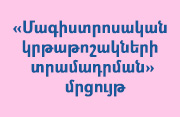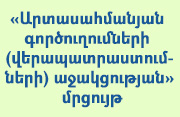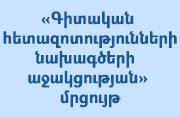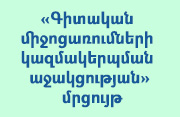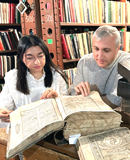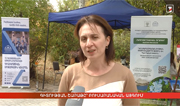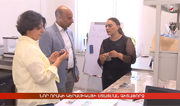|
|
|
|
|
 |
|
Scientific Center of Zoology and Hydroecology
Division of Natural Sciences
Specialization: Zoology, parasitology, hydrobiology, ecology, nature protection |
|
| Founded year: |
2006 |
| Director: |
PhD
Sargis A. Aghayan
|
| Address: |
7, P. Sevak st., Yerevan 0014, Republic of Armenia |
| Phone number: |
(+374 10) 28 59 61, (+374 10) 20 75 92, (+374 10) 28 16 01 |
| E-mail: |
zoohec {[ at ]} sci.am |
| Website: |
https://sczhe.sci.am/ |
|
General Information
Deputy Director: Gor A. Gevorgyan,
PhDScientific Secretary: Hasmik G. Khachatryan, PhD
The Center was established by governmental decree in 2006 as a result of reorganization by integrating the Institute of Zoology of the NAS RA and the Institute of Hydroecology and Ichthyology of the NAS RA. According to the same decree and the statues of the Institutes, each of them is the main scientific subdivision of the Center, carrying out fundamental research activities. The Institute of Zoology is the leading organization օf the republic in the field of zoological science. The Institute of Hydroecology and Ichthyology is the only specialized organization in Armenia for the study of limnosystems.
Institute of Zoology
Head: Mark Yu. Kalashyan, PhD
Laboratories
- Zoology of vertebrates (head: Mamikon G. Ghasabyan, PhD)
- Entomology and soil zoology (head: Мark Yu. Kalashyan, PhD)
- General helminthology and parasitology (head: Marine V. Vardanyan, PhD)
- Experimental zoology (acting head: Victor E. Spangenberg, PhD)
- Molecular parasitology (head: Hasmik Sh. Gevorgyan, PhD)
Scientific groups
- Paleozoology (supervisor: Andranik A. Gyonjyan, PhD)
- Invertebrate ecology (supervisor: Noushig H. Zarikian, PhD)
- Parasitology of small mammals (supervisor: Vahram T. Hayrapetyan, DrSc)
Other structures
- Zoological museum (acting head: Andranik A. Gyonjyan, PhD)
- Scientific collection of invertebrates (responsible: Aida A. Avetisyan)
- Osteological collections (responsible: Nina H. Manaseryan, DrSc)
- Joint scientific-experimental center of the Institute of Zoology of the Center of Zoology and Hydroecology of NAS RA and the Center of Parasitology of the Institute of the Problems of Ecology and Evolution named after A. N. Severtsov of the Russian Academy of Sciences (RA JSEC) (scientific supervisor: Sergey H. Movsesyan, NAS RA Academician, DrSc, head: Aram L. Aghasyan, PhD)
Institute of Hydroecology and Ichthyology
Head: Evelina Kh. Ghukasyan, PhD
Laboratories
- Ichthyology (acting head: Nelli E. Barseghyan, PhD)
- Hydrobiology (head: Susanna H. Hakobyan, PhD)
- Applied hydroecology (head: Gor A. Gevorgyan, PhD)
Scientific groups
- Studies of aquatic ecosystem services (supervisor: Vardan L. Asatryan, PhD)
Other structures
- Scientific library (head: Anahit H. Mkrtchyan)
- Specialized Council 036 of the HQC RA for the defense of candidate and doctoral dissertations in the specialty 03.00.08 –"Zoology, parasitology, ecology".
Main Fields of Activity
- Studies of hydro-and terrestrial ecosystems of Armenia,
- Studies of diversity, taxonomy, morphology, ecology, ethology, evolution, genetics, geography of invertebrate, vertebrate animals and hydrobionts of Armenia,
- Studies of parasitic fauna of animals,
- Assessment of bioresources, development of methods for their conservation, restoration and sustainable use,
- Study and assessment of ecosystem service,
- Organization and realization of scientific-education, marketing, innovation and commercialization activities.
Total number of staff of the Center- 124, scientific staff - 90, including Candidates of science (PhD) – 48, Doctors of science (DrSc) – 4, Academicians – 1
Main Results
A combination of conventional and cutting-edge biological research methods is being used to study quantitative and qualitative aspects of the fauna and hydrobionts of Armenia, assess their current state and identify existing and potential threats. Special emphasis is placed on examining endangered and invasive species, as well as species holding potential for biological control, animal and plant parasites and agricultural pests:
- A comparative evaluation and compilation of data have been performed on osteological material gathered from archaeological sites in the northwestern Armenia dating back to the 3rd-1st millennium BC. Both qualitative and quantitative changes have been observed in the mammalian fauna, suggesting shifts in the region’s ecosystems and climate.
- Over the course of the past 10 years, approximately 150 new species have been discovered for the arthropod fauna of Armenia and 4 species new for science have been described. Based on the most recent data, the vertebrate fauna, amounts to a total of 572 species. A subspecies of Common Crane – Grus grus archibaldi new for science has been described from Armenia. An extensive amount of data has been collected to update the Red Data Book of Animals of Armenia․ A taxonomic list and species accounts for 29 insect species of Armenia have been prepared and submitted to the Species Survival Commission (SSC) of the International Union for Conservation of Nature (IUCN) for the IUCN Red List. The Caucasian Biodiversity Barcode Platform has been enriched with DNA sequencing results for nearly 2000 samples of terrestrial and aquatic animals of Armenia.
- Studies on phenotypic and genotypic changes in fish and amphibian populations occurring in habitats contaminated with heavy metals were conducted.
- First research efforts in the last 50 years were undertaken to collect data on the waterbird diversity, occurrence status, habitat suitability and the extent of human pressure within the restricted military border strip of the mid reaches of the Araks River.
- Research was held into fauna, ecological and biological characteristics of the most pathogenic helminths and ticks serving as vectors of parasitic diseases:
– A total of 220 species of nematodes and acanthocephalans have been identified in Armenia. New taxonomic and biological classifications for tapeworms have been proposed.
– Genotyping of pathogens which cause zoonotic diseases such as echinococcosis, toxoplasmosis, and dirofilariasis was performed for the first time in Armenia and revealed the prevalence of pathogenic strains associated with these diseases in our country.
– Widely distributed ecto- and endoparasitic nematodes have been identified in fruit trees, conifers and grapevines, including pathogenic phytonematodes that act as vectors of viruses in both wild and cultivated plants.
- The rich scientific collection funds of the Center and the Zoological Museum have been enriched with new materials and exhibits, a corner showcasing live nature has also been created.
- A study of the hydroecosystems of Armenia is being carried out:
– Since 2010 studies were carried out to examine the condition of spawning grounds for endemic fish species in Lake Sevan, and assess the forage base of the fish.
– Causes of eutrophication in Lake Sevan resulting from morphometric changes have been identified.
– The genetic diversity of planktonic bacteria in Lake Sevan has been studied for the first time.
– Monitoring and assessment of the ecological status of the lake is underway.
– Monitoring of hydrobiological parameters in transboundary rivers has been completed and their ecological status has been assessed.
Results of applied research
- Proposals submitted to the RA Ministry of Environment refer to management of
– aquatic ecosystems and biodiversity resources;
– revision of fish harvesting methods;
– regulation and effective control of river channels;
– requirements and management principles applied to industrial sites involved in the exploitation of hydrobionts;
– restoration of industrial stocks, management of fish and crayfish resources.
- A one-dimensional (1D) model for assessing the thermal regime of Lake Sevan has been developed.
- As a result of continuous high-frequency measurements, a large volume of water quality data has been collected in Lake Sevan.
- An assessment was undertaken to measure the impact of small hydropower plants constructed on the Arpa River and its tributaries, Herher and Yeghegis. The most effective approaches for measuring the impact of these small hydropower plants have been proposed.
- A system of multi-parameter indicators to assess the condition of ecological status in rivers has been developed for several major rivers in Armenia.
- Upon commission by the RA Ministry of Environment the current state of the main game species populations in Armenia has been assessed for 2020-2023. Diversity and population numbers of game species was estimated. Distribution ranges, hunting bags of harvestable game species and dates of hunting seasons were determined.
- Measures have been developed for the treatment and prevention of various parasitic diseases in livestock and cultivated plants, including the environmentally-friendly strategies for controlling agricultural pests:
– Proposals were developed and submitted to the RA Ministry of Agriculture to control lung and gastrointestinal helminthiasis in sheep and goats in the foothill zones of Armenia.
– Extracts derived from different plant species were developed and tested to assess their insecticidal and acaricidal properties and effectiveness.
– A methodology has been developed to maintain the laboratory population of an effective biological control agent - the predatory mite Phytoseiulus persimilis at low temperatures.
Main publications
About 7000 articles and materials of scientific conferences have been published,100 monographs, including 7 Indexes of fauna of Armenia, 12 volumes of “Fauna of Armenian SSR”, 23 volumes of Zoological article collections, Proceedings of Sevan Hydrobiological Station (20 volumes), 2 collective monographs of joint Armenian-Russian studies on Lake Sevan, 3 monographs of RA JSEC joint research, the handbook “Agriculture, forest and storehouse pests of Armenia”, The Red Book of Armenian SSR (Animals)” (1987) , “The Red Book of Animals of the Republic of Armenia” (2010), 3 volumes of Proceedings of International Scientific Conference «Biological diversity and conservation problems of the fauna» (2011, 2014, 2017) and other.
Awards
The scientific work performed by the specialists of the Institute was honored by State awards, including golden (R. Sarkisov, 1979), silver ( S. Movsesyan, 1959; A. Sevumyan, 1979), and bronze (L. Mkrtchyan, 1979) medals in Exhibitions of Achievements of National Economy of USSR, State Award of Armenian SSR (S. Iablokoff-Khnzorian, 1985), RAN Award after ak. K.Skryabin (S.Movsesyan, 2002), the Distinguished Scientist of RA award (S.O. Movsesyan, 2013), Medal of the Prime-Minister of the Republic of Armenia (G. Sargisov, 2011), Medals of the Minister of Nature Protection of RA (A. Aghasyan, M. Kalashyan, 2011; E.Ghukasyan, 2015, B.Gabrielyan, 2016 ), the Distinguished Scientist of RA award (S.O. Movsesyan, 2013), Medal of the Order of Merit for the Fatherland, II degree (S.O. Movsesyan, 2020), Boghossian Prize (former presidents' award) 2020 award in the field of Life Sciences Development (S. Aghayan, 2020) and other.
International Activity
- In 1996 Russian-Armenian Joint Scientific Experimental Center (RA JSEC) has been established by agreement between the A.N. Severtsov Institute of Ecology and Evolution of the Russian Academy of Sciences and the Institute of Zoology of the SCZH NAS RA and located in Nor Artamet village of Kotayk marz. This is the first joint scientific unit in entire NIS, which allowed re-establishing of lost collaboration between NAS RA and RAS. The JSEC serves as a base for experimental Parasitology and other zoological studies. Here the collaborative (with Russian specialists) efforts in experimental studies dedicated to important issues to biodiversity, zoology and parasitology, and tests of effective and environmentally safe methods of agricultural pest control are implemented. Тhe results of joint research have great scientific and practical importance and are presented in more than 70 national, regional and international peer-reviewed publications, including three monographs.
- According to the agreement signed in 1993 between the Institute of Biology of Inland Waters after I. D. Papanin of the Russian Academy of Sciences and the Institute of Hydroecology and Ichthyology of the National Academy of Sciences of the Republic of Armenia on scientific cooperation the program "Joint Study of the current ecological state of Lake Sevan” is carried out and annually "Armenian-Russian joint scientific expedition" is organized in the Lake Sevan basin. The long-term research results are summarized in 2 collective monographs.
- Were organized:
– 3 international conferences “Biological Diversity and Problems of Fauna Protection” (2011, 2014, 2017) (on the initiative of the National Center of Zoology and Hydroecology of the NAS RA, together with the A.N. Severtsov Institute of Ecology and Evolution of the Russian Academy of Sciences and the American University of Armenia);
– 2 international scientific conferences of young scientists “Biodiversity and environmental problems of wildlife conservation”, dedicated to the 70th and 75th anniversary of the National Academy of Sciences of the Republic of Armenia (2013, 2018) ( together with the Institute of Botany after A.L. Takhtajyan of the NAS RA).
Other Information
Suggestions and recommendations on creation of a protected area network, modification of the existing boundaries and establishment of new protected areas are continuously developed. The specialists of the Center are participating in the preparation of legistative acts of the Republic of Armenia (including lows, decisions of the Government, etc.) and documents representing Armenia internationally, in particular, National Reports and Cmmunications to the International Conventions (UN CBC, UN FCCC, UN CBD, Bern, CITES, etc.).
The Center periodically organizes national, regional and international scientific conferences.
During the research, the scientists of the Center continuously collect information on the species in need of protection and participate in in the revision and update of the RA Red Book of animals.
|
|
|
|
|
Notices
Publications in Press
17/10/2025
1lurer.am |
15/10/2025
1lurer.am |
10/10/2025
hesc.am |
09/10/2025
hesc.am |
This site has been visited
7 496 914
times since 01.01.2005
|
|
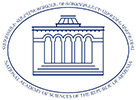


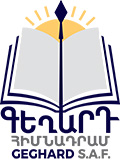
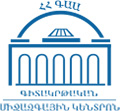









![academy [@] sci.am academy [@] sci.am](images/email.jpg)










